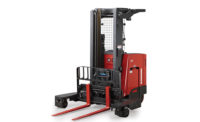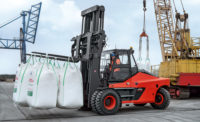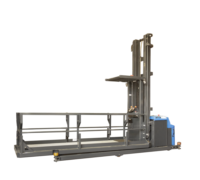Warehouse managers are continuously seeking ways to maximize efficiency and productivity within their operations. Industry challenges, such as on-demand warehousing to meet ever-increasing consumer demands, have left organizations looking for solutions to enhance productivity and boost operational performance. To find efficiencies, warehouse managers are investigating the benefits of alternative energy solutions technology that may better support their needs.
Traditional energy solutions may make it difficult to address these around-the-clock demands. Thus, it makes sense that nearly 31% of manufacturing and supply chain organizations say they will prioritize investment in batteries and chargers over the next three years, according to a report released by MHI, the Charlotte, N.C.-based producer of the MODEX and ProMat tradeshows.
Fortunately, battery manufacturers — and an increasing number of lift truck providers — are introducing alternative energy solutions, like lithium-ion batteries.
Benefits of efficient charging
Warehouses always want to do more. Aiming to lift higher and heavier loads, trucks can run longer without interruption based on their energy source. Lithium-ion batteries have a very high energy density — about triple the capacity of a similar lead-acid battery. Energy density is a measure of how much energy a battery can hold in a given volume or battery box space. The more energy in the forklift battery box, the longer the runtime will be. Lithium-ion batteries offer the highest energy densities.
Another benefit of lithium-ion batteries is their ability to be opportunity-charged. Lithium-ion batteries charge in shorter periods of time than traditional lead-acid batteries. For example, within a 3-shift operation, a warehouse could have three lead-acid battery packs per truck — one in the truck for a shift, one in the charging room for a shift and one cooling for a shift. In many applications, a single lithium-ion battery could be used with the proper method of charging or what we would call “opportunity charging.” This allows operators to take advantage of breaks, lunch hours or shift changes to recharge in the truck (no battery removal/replacement) and maintain battery performance throughout their shift. Centralized battery rooms can be eliminated by using opportunity charging stations located throughout the warehouse. The truck can be driven right to the charging station for charging in a very efficient manner. This means there’s no need to swap out batteries during a shift, which changes the entire logistics of keeping trucks charged and running.
Lithium-ion batteries are maintenance-free and are considered intelligent batteries that can report a battery’s status and react to all aspects of its performance — from the state of its charge to its actual state of health.
Thinking long-term
There are costs involved with any new technology. However, it’s important to take a total cost of ownership approach when making buying decisions for alternative energy solutions to ensure long-term cost savings can be considered.
For operations managers not ready for lithium-ion batteries, but would like to implement lead-acid alternatives, thin plate pure lead technology (TPPL), an additional alternative energy solution, offers a maintenance-free lead-acid battery with no watering requirements or weekly equalization charges. A TPPL battery can be charged at rates of up to 100%, without risk of damage from overheating. Operations that don’t have duty cycles to support a lithium purchase should consider this as a middle-ground solution.
Next steps toward implementation
Research is crucial for determining the best energy solution for your operation. Battery manufacturers actively study power consumption to understand battery requirements by using power studies.
During a power study, an e-meter is plugged into the truck and logs current, voltage, cumulative charge and discharge amp-hours and watt hours, temperature and cellular service quality on all electric trucks. The meter tracks the battery’s performance throughout shifts, which helps you realize how much energy the battery is consuming. With this information, you can understand the true power consumption within applications.
Battery usage of one truck may be completely different than another. For example, if a grocery operation has two warehouse or distribution center locations, one for frozen foods and the other for dry goods, the energy usage for a reach truck in both locations will be significantly different. Based on these differences, the third-party provider can offer customized recommendations on the most cost-effective product offering to address these specific energy needs, truck by truck.
A power study is an effective first step toward identifying the best solutions for your operations. Additionally, it creates an ongoing dialogue with the battery provider who can create informed product recommendations.
Although lithium-ion batteries present several benefits for organizations, it’s important to remember they aren’t all created equal. Chemistries, manufacturing processes, materials and testing protocols differ from offering to offering. Underwriters Laboratories (UL), Northbrook, Ill., offers assistance in navigating these complexities. As an independent third-party, UL performs rigorous product testing and evaluates compliance with externally specified product requirements.
UL has two industry markings it gives to lithium-ion batteries—UL Listed and UL Recognized.
A UL Listed mark indicates a product has been tested by UL and meets nationally recognized safety standards. A UL Listed product example would be a complete lithium-ion battery pack that has a mechanical enclosure and electronic circuit protection, and demonstrated full construction and testing compliance to the standard’s requirements.
A UL Recognized mark appears on products that may have restrictions on their performance or may be incomplete in construction. An example of this would be a lithium-ion battery pack that does not yet include a mechanical enclosure, but will have one in the final end product it will be housed in.
Even if you don’t choose lithium-ion as an alternative energy solution, you can still take measures toward greater battery efficiency. Identifying and implementing the right energy solutions can save money, enable a smarter warehouse and lead to changes that can make your organization more efficient.



